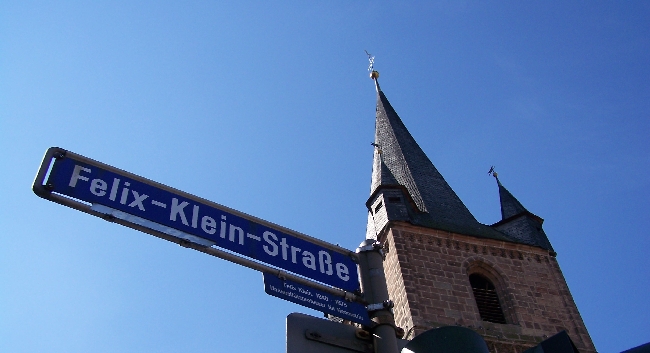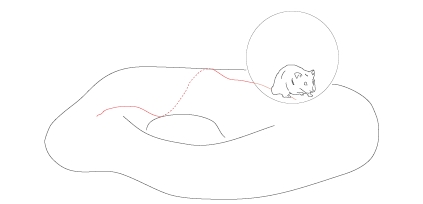Klein 2-Geometry XII
Posted by John Baez
Back in May 2006, David Corfield wrote a blog entry called Klein 2-geometry, saying:
As a small experiment in collective, public thinking, I’m going to devote a post to the attempt to categorify Kleinian geometry, and update the date so it doesn’t slip off the radar of ‘Previous Posts’.
His question was:
What prevents an Erlangen program for 2-groups?
The Erlangen program, is, of course, Felix Klein’s plan to study highly symmetrical spaces by thinking of them as quotient spaces where is a group and a subgroup. If you’ve heard of this program but never really read about it, you might like his recent review article:
- Felix Klein, A comparative review of recent researches in geometry, arXiv:0807.3161.
Generalizing this idea to 2-groups (or beyond) seemed like a great idea, and David’s original post helped trigger the formation of the n-Category Café. The discussion went on and on, all the way to Klein Geometry XI. However, it never developed to the height of magnificence that I’d hoped, mainly because of the lack of a clear goal.
But then this summer I went to Erlangen, and talked to Derek Wise…
Derek has thought deeply about gravity and Cartan geometry. As I mentioned, Klein geometry studies beautiful, symmetrical spaces of the form . Cartan geometry is a generalization of Klein geometry that studies lumpy, bumpy spaces that are locally, approximately shaped like .
A famous example is Riemannian geometry. This studies manifolds that locally, approximately look like Euclidean space. Euclidean space is where is the Euclidean group and is the rotation group. Each point of a Riemannian manifold has a ‘tangent space’ that looks exactly like Euclidean space. That’s the idea of Riemannian geometry: it studies spaces that locally, approximately look like Euclidean space — and this approximation becomes perfect in the limit.
But there’s another example of Cartan geometry that studies manifolds where each point has a ‘tangent sphere’. And there’s another that studies manifolds where each point has a ‘tangent hyperbolic space’. And there’s another that studies manifolds where each point has a ‘tangent deSitter spacetime’. Hmm, that’s starting to sound a bit like our universe! Yes, we can say as usual that each point has a ‘tangent Minkowski spacetime’, but if the cosmological constant is nonzero, the ‘default’ for spacetime is not flat like Minkowski spacetime, but slightly curved, like deSitter’s expanding universe.
If you don’t know what I mean, don’t worry — these are just different choices of .
Anyway, one dark and stormy night Derek and I were walking around Erlangen, when we heard a ghostly voice, calling out:
You must categorify my program, and the work of Cartan!
We looked around, but we couldn’t see where the voice was coming from. Then I heard:
You must use the Poincaré 2-group… and don’t forget torsion…
I felt a cold hand on my shoulder. I twisted around, trying to elude its icy clutch. I didn’t see anyone.
My panic was so great I must have fainted. When I came to I was lying near the side of the road. Evidently a whole night had passed. When I looked up, this is what I saw:
Derek was already awake, scribbling frantically in a notebook in a nearby café. In the grip of inspiration, he hadn’t even bothered to revive me. He wordlessly handed me a cup of coffee, and then explained his ideas.
The Poincaré 2-group is an easy example of a strict Lie 2-group: it has the Lorentz group as its group of objects, and for each object, the translation group of Minkowski spacetime as its group of automorphisms. Crane and Sheppeard suggested using this 2-group to build a ‘state sum model’—that is, a kind of quantum field theory of sorts. After considerable work this was achieved, not for the Poincaré 2-group, but for the closely related ‘Euclidean’ 2-group, which is easier because the group of objects, now the rotation group, is compact. The result turned out to be closely related to Baratin and Freidel’s spin foam model of flat spacetime.
However, physical meaning of the Poincaré 2-group remains obscure. Why? Because we don’t know a classical field theory involving a 2-connection for the Poincaré 2-group! Such a 2-connection would look locally like a 1-form taking values in the Lie algebra of the Lorentz group, together with a 2-form taking values in the Lie algebra of the translation group!
Of course, we get a 1-form taking values in the Lie algebra of the Lorentz group whenever we’re studying gravity, because that’s what a metric-compatible connection on a Lorentzian manifold looks like, locally. But a 2-form taking values in the Lie algebra of the translation group? Where would we ever get a thing like that?
Wait — that’s exactly what torsion is! Given a connection on the tangent bundle of a manifold, its torsion is defined by You can think of as a 2-form taking values in the tangent bundle—or locally speaking, in the Lie algebra of the translation group.
On a Riemannian or Lorentzian manifold, the Levi-Civita connection is the unique metric-compatible connection with vanishing torsion, and the curvature of this connection describes gravity. But for manifolds meeting some restrictions on their topology, one can also find a metric-compatible connection with vanishing curvature, called the Weitzenböck connection, and then the torsion of this connection is nonzero, and interesting.
There is, in fact, a way to rewrite general relativity involving the Weitzenböck connection. This is called teleparallel gravity. This theory seems conceptually quite different than general relativity. For example, in this theory, unlike in general relativity, gravity is seen as a force. This force makes freely falling particles deviate from geodesics as defined by the Weitzenböck connection.
It sounds wacky! However, teleparallel gravity is completely equivalent to general relativity… at least in the absence of spinning matter… at least on manifolds with trivial tangent bundles.
So, without coming out and ‘endorsing’ teleparallel gravity, it’s still interesting to see if we can write it as a higher gauge theory, involving a 2-connection for the Poincaré 2-group. And, after a month or two of work, it seems to be working:
- John Baez and Derek Wise, Teleparallel gravity as a higher gauge theory I. (Draft version.)
Moreover, we even seem to be seeing strong clues that teleparallel gravity can nicely understood using Cartan 2-geometry! In part I here, we take you to the brink of believing that… and then explain why it’s not as easy as it sounds. In part II we’ll show how to do it. So, this paper ends on a bit of a cliffhanger.
Nonetheless, there’s enough to see here that we’d like you take a look and say what you think! We make no claims as to the ultimate importance of these ideas, but they do seem kind of fun.



Re: Klein 2-Geometry XII
When I had a trackback mentioning the word ‘teleparallel’ in my inbox, I felt sure there was some crank about. How pleasant to find it’s back to Klein 2-geometry.
Let’s see if predictions about what Cartan 2-geometry might involve are close.